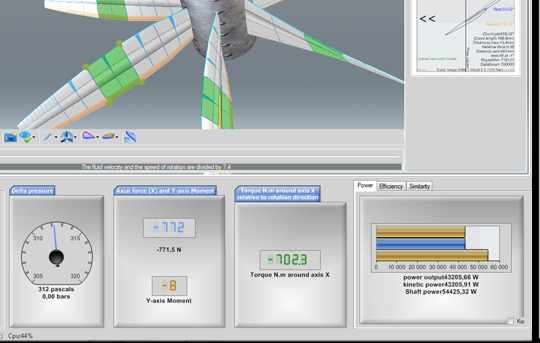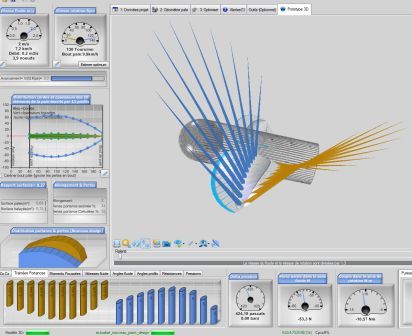design propeller turbine, kaplan, foil, wings with 3D heliciel software:
discover heliciel software and Mecaflux suite softwares
propellers turbines and wings performance calculations
How to edit and showing propeller, turbine or wing performances in Heliciel software:
After a setting, we rebuilt the blade or wing. Performance are calculated and the results are presented in various forms. When we design a propeller or wing, the main question is usually:
- How much energy do I need to obtain an amount of energy transformed?
- For a wing: How fast should I reach to the desired lift? What is the thrust to provide to maintain this speed?
- For a propulsion propeller: What power on the shaft do I need to get the desired thrust
- For a propeller fan: What power on the shaft do I need to obtain the desired increase in pressure.
- For wind turbine: What wind speed will give me the desired power shaft.
Pressure, torque, thrust, power and performance are given here for the propeller or wing:

- Coefficient de traînées et de portances des éléments de pale ou d'aile:

- Drag and lift (in newtons) of the blade elements or wing

- Moment and thrust blade elements or wing:

- Detailed results of distribution induced velocities blade elements:

- Detailed results of the distribution of fluid elements blade angles:

- Detailed results of the distribution of angles profiles blade elements:

- Detailed results of distribution of resistances blade elements:

- Detailed results of pressure distribution per blade element:

Here we see the drag and lift of the blade: on each element:

Here we see how the break detection elements is shown in red in the graph, but also on the 3D representation of the propeller (The selected material is polystyrene here, then at 800 revolutions per minute..rupture!) :


 Global site map
Global site map Mecaflux
Mecaflux Tutorials Mecaflux Pro3D
Tutorials Mecaflux Pro3D Tutorials Heliciel
Tutorials Heliciel Mecaflux Store
Mecaflux Store Compare software functions
Compare software functions Quotes, Orders, Payment Methods
Quotes, Orders, Payment Methods project technical studies
project technical studies